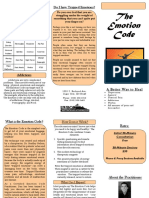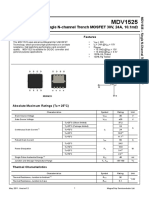0 ratings0% found this document useful (0 votes)
114 viewsPowder Contrail Generation
Powder Contrail Generation
Uploaded by
abrkCopyright:
Attribution Non-Commercial (BY-NC)
Available Formats
Download as PDF or read online from Scribd
Powder Contrail Generation
Powder Contrail Generation
Uploaded by
abrk0 ratings0% found this document useful (0 votes)
114 views4 pagesCopyright
© Attribution Non-Commercial (BY-NC)
Available Formats
PDF or read online from Scribd
Share this document
Did you find this document useful?
Is this content inappropriate?
Copyright:
Attribution Non-Commercial (BY-NC)
Available Formats
Download as PDF or read online from Scribd
Download as pdf
0 ratings0% found this document useful (0 votes)
114 views4 pagesPowder Contrail Generation
Powder Contrail Generation
Uploaded by
abrkCopyright:
Attribution Non-Commercial (BY-NC)
Available Formats
Download as PDF or read online from Scribd
Download as pdf
You are on page 1of 4
United States Patent 0» un 3,899,144
Werle et al. {45] Aug. 12, 1975
[5] POWDER CONTRATL GENERATION 2085865 6/1936 Morey. sons
Boise 4/1982 Walon. asx
(751 Inventors: Donald K. Werle, Hillside; Romas 252/988 31982, Milleon wn aux
Kasparas, Riverside: Sidney Katz, "Ris711 3/1928 Sane 40213
Chicago, all oft
One eee FOREIGN PATENTS OR APPLICATIONS
nee ercoeated by the Seoretay of the 022,621 371966 United Kingdom. - 2Ai)s
Navy, Washington, D.C
2 a ees ase ore ‘Assistant Examiner—Barry L. Kelmachter
{21} Appl. No. 490,610 ‘Attorney, Agent, or Firm Richard S. Sciscia; Joseph
MSt Amand
(52) US. 244/136; 40/213; 116/114 F;
24/3 (57) ABSTRACT
[SE] Int. CL, = sosserrinsersssseerss BOSD 116
Me en ee cc SaGTS AUR OAT, Light scattering pigment powder particles, surface
Sen Das 4 B30/teLe tigjaa Re Lieig, Weated to minimize interparticle cohesive forces, are
Tit Boia M, 124 Re ia4'b, 14 ¢ dispensed from a jet mill deagglomerator as separate
Single particles to produce a powder contrail having
at eee ‘maximim visibly or radiation seatering ably for 4
UNITED STATES PATENTS siven weight material
1.619183 3/1927 Bradner eta 244/136 12 Claims, 1 Drawing Figure
POWDER woPPeR
revi orn oman Saat
ee os a
a
4
3 rea
* opaleml eT hpe fe
287297 30: ae
\ ‘DEAGGLOMERATOR OUTLET 36
\ aaa aie TUBE ] iy FILL VALVE. v4 eA OMERATOR
a MAIN TUBE- ‘DEAGGLOMERATION CHAMBER /
SOLENOID VALVE
3,899,144
PATENTED AUS 1 21875
BAIA GION3TOS:
61 N3GWWHO NOLLW¥aWOT99v30 3an1 NIVW
8 BLVTd ,INMLNAA,
‘or
be 32
9¢ 1F11N0 YoLwwaWO99W30 ( aa ny
San. iv Woes
TUWeLNOD
<—
se
92
L {
2 tear ta
N
4Y3BddOH Y30MOd-
NoILoauIa LH9.g ——— >
1 6ly
3,899,144
1
POWDER CONTRAIL GENERATION
BACKGROUND.
‘The present invention relates to method and appara:
tus for contrail generation and the Tike
‘An earlier known method in use for contrail genera:
tion involves oil smoke trails produced by injecting liq-
uid oil dircetly into the hot jet exhaust of an aircraft tar-
get vehicle. The oil vaporizes and recondenses being.
the aircraft producing a brilliant white trail. Oil smoke
trail production requires a minimum of equipment,
and, the material is low in cost and readily available.
However, oil smoke requires a heat source to vaporize
the liquid oil and not all aircraft target vehicles, notably
towed targets, have such a heat source. Also, at alti
tudes above about 25,000 feet oil smoke visibility de-
grades rapidly,
SUMMARY
‘The present invention is for a powder generator re-
quiring no heat source to emit a “contrail” with suffi
cient visibility to aid in visual acquisition of an aircraft
target vehicle and the like. The term “contrail” was
adopted for convenience in identifying the visible pow-
der trail of this invention. Aircraft target vehicles are
used to simulate aerial threats for missile tests and
often fly at altitudes between 5,000 and 20,000 feet at
speeds of 300 and 400 knots or more. The present in-
vention is also suitable for use in other aircraft vehicles
to generate contrals or reflective screens for any de-
sired purpose. .
‘The powder contail generator is normally carried on
an aircraft in a pod containing a ram air tube and pow-
der feed hopper. Powder particles, surface treated to
‘minimize interparticle cohesive forces are fed from the
hopper to a deagglomerator and then to the ram
tube for dispensing as separate single particles to pro-
duce a contrail having maximum visibility for a given
‘weight material
‘Other object, advantages and novel features of the
invention will become apparent from the following de-
tailed description of the invention when considered in
conjunction with the accompanying drawing,
DESCRIPTION OF DRAWING
FIG. 1 is a schematic sectional side-view of a powder
ccontrail generator of the present invention.
DESCRIPTION OF PREFERRED EMBODIMENT
The powder contail generator in pod 10, shown in
FIG. 1, is provided with a powder feed hopper 12 posi-
tioned in the center section of the pod and which feeds
powder 13 to a deagglomerator 14 by means of screw
conveyors 16 across the bottom of the hopper. The
deagglomerator 14 produces two stages of action. In
the first stage of deagglomeration, a shaft 18 having
projecting radial rods 19 in compartment 20 is rotated
by an air motor 21, of other suitable drive means. The
shaft 18 is rotated at about 10,000 rpm, for example.
As powder 13 descends through the first stage com-
partment 20 of the deagglomeration chamber, the ham-
ering action of rotating rods 19 serves to aerate and
precondition the powder before the second stage of,
You might also like
- The Subtle Art of Not Giving a F*ck: A Counterintuitive Approach to Living a Good LifeFrom EverandThe Subtle Art of Not Giving a F*ck: A Counterintuitive Approach to Living a Good LifeRating: 4 out of 5 stars4/5 (5940)
- The Gifts of Imperfection: Let Go of Who You Think You're Supposed to Be and Embrace Who You AreFrom EverandThe Gifts of Imperfection: Let Go of Who You Think You're Supposed to Be and Embrace Who You AreRating: 4 out of 5 stars4/5 (1107)
- Never Split the Difference: Negotiating As If Your Life Depended On ItFrom EverandNever Split the Difference: Negotiating As If Your Life Depended On ItRating: 4.5 out of 5 stars4.5/5 (887)
- Hidden Figures: The American Dream and the Untold Story of the Black Women Mathematicians Who Helped Win the Space RaceFrom EverandHidden Figures: The American Dream and the Untold Story of the Black Women Mathematicians Who Helped Win the Space RaceRating: 4 out of 5 stars4/5 (925)
- Grit: The Power of Passion and PerseveranceFrom EverandGrit: The Power of Passion and PerseveranceRating: 4 out of 5 stars4/5 (598)
- Shoe Dog: A Memoir by the Creator of NikeFrom EverandShoe Dog: A Memoir by the Creator of NikeRating: 4.5 out of 5 stars4.5/5 (545)
- The Hard Thing About Hard Things: Building a Business When There Are No Easy AnswersFrom EverandThe Hard Thing About Hard Things: Building a Business When There Are No Easy AnswersRating: 4.5 out of 5 stars4.5/5 (353)
- Elon Musk: Tesla, SpaceX, and the Quest for a Fantastic FutureFrom EverandElon Musk: Tesla, SpaceX, and the Quest for a Fantastic FutureRating: 4.5 out of 5 stars4.5/5 (476)
- Her Body and Other Parties: StoriesFrom EverandHer Body and Other Parties: StoriesRating: 4 out of 5 stars4/5 (831)
- The Emperor of All Maladies: A Biography of CancerFrom EverandThe Emperor of All Maladies: A Biography of CancerRating: 4.5 out of 5 stars4.5/5 (274)
- The World Is Flat 3.0: A Brief History of the Twenty-first CenturyFrom EverandThe World Is Flat 3.0: A Brief History of the Twenty-first CenturyRating: 3.5 out of 5 stars3.5/5 (2272)
- The Yellow House: A Memoir (2019 National Book Award Winner)From EverandThe Yellow House: A Memoir (2019 National Book Award Winner)Rating: 4 out of 5 stars4/5 (99)
- The Little Book of Hygge: Danish Secrets to Happy LivingFrom EverandThe Little Book of Hygge: Danish Secrets to Happy LivingRating: 3.5 out of 5 stars3.5/5 (419)
- Devil in the Grove: Thurgood Marshall, the Groveland Boys, and the Dawn of a New AmericaFrom EverandDevil in the Grove: Thurgood Marshall, the Groveland Boys, and the Dawn of a New AmericaRating: 4.5 out of 5 stars4.5/5 (270)
- The Sympathizer: A Novel (Pulitzer Prize for Fiction)From EverandThe Sympathizer: A Novel (Pulitzer Prize for Fiction)Rating: 4.5 out of 5 stars4.5/5 (122)
- Team of Rivals: The Political Genius of Abraham LincolnFrom EverandTeam of Rivals: The Political Genius of Abraham LincolnRating: 4.5 out of 5 stars4.5/5 (235)
- A Heartbreaking Work Of Staggering Genius: A Memoir Based on a True StoryFrom EverandA Heartbreaking Work Of Staggering Genius: A Memoir Based on a True StoryRating: 3.5 out of 5 stars3.5/5 (232)
- Arcturian TechDocument17 pagesArcturian Techabrk100% (3)
- Silva Method PDFDocument7 pagesSilva Method PDFabrk0% (1)
- On Fire: The (Burning) Case for a Green New DealFrom EverandOn Fire: The (Burning) Case for a Green New DealRating: 4 out of 5 stars4/5 (75)
- Lenovo G580 Compal La-7981p r1.0 SchematicsDocument63 pagesLenovo G580 Compal La-7981p r1.0 SchematicsabrkNo ratings yet
- The Unwinding: An Inner History of the New AmericaFrom EverandThe Unwinding: An Inner History of the New AmericaRating: 4 out of 5 stars4/5 (45)
- AutoGenic TrainingDocument15 pagesAutoGenic TrainingStarkiller CanasdNo ratings yet
- The Key To All SuccessDocument3 pagesThe Key To All SuccessabrkNo ratings yet
- Transurfing - The New Reality MethodDocument1 pageTransurfing - The New Reality MethodabrkNo ratings yet
- Not Only Is The Universe Stranger Than We Imagine, It Is Stranger Than We Can Imagine PDFDocument29 pagesNot Only Is The Universe Stranger Than We Imagine, It Is Stranger Than We Can Imagine PDFabrkNo ratings yet
- Silva MethodDocument7 pagesSilva Methodabrk100% (1)
- The Emotion Code Free Report v2 PDFDocument10 pagesThe Emotion Code Free Report v2 PDFabrk75% (4)
- ECBrochure PDFDocument2 pagesECBrochure PDFabrk100% (1)
- Awakening of Kundalini Through Yoga - Dr. Kamakhya KumarDocument6 pagesAwakening of Kundalini Through Yoga - Dr. Kamakhya KumarabrkNo ratings yet
- MC14541B DDocument9 pagesMC14541B DabrkNo ratings yet
- FR9886Document12 pagesFR9886abrkNo ratings yet
- Single N-Channel Trench MOSFET 30V, 24A, 10.1m : Features General DescriptionDocument7 pagesSingle N-Channel Trench MOSFET 30V, 24A, 10.1m : Features General DescriptionabrkNo ratings yet
- Listen, Little Man! - Wilhelm Reich PDFDocument50 pagesListen, Little Man! - Wilhelm Reich PDFabrkNo ratings yet























































